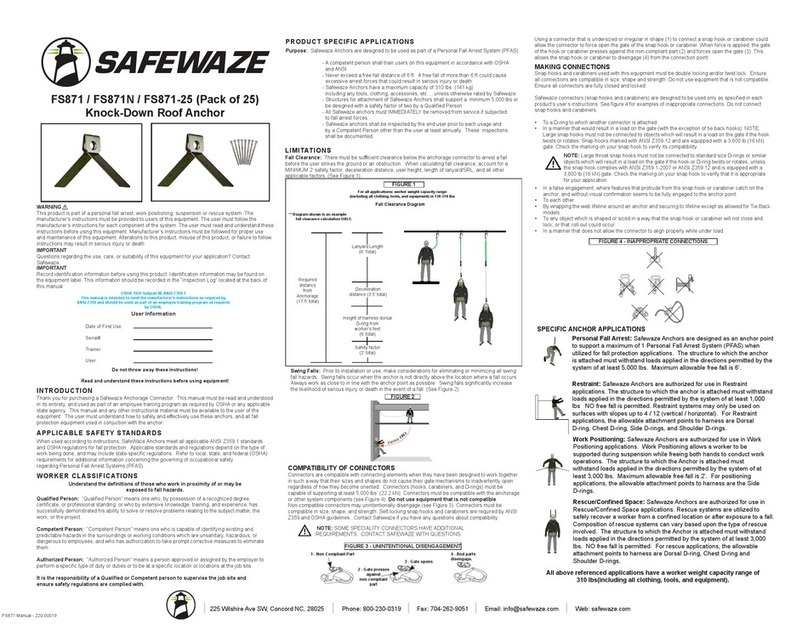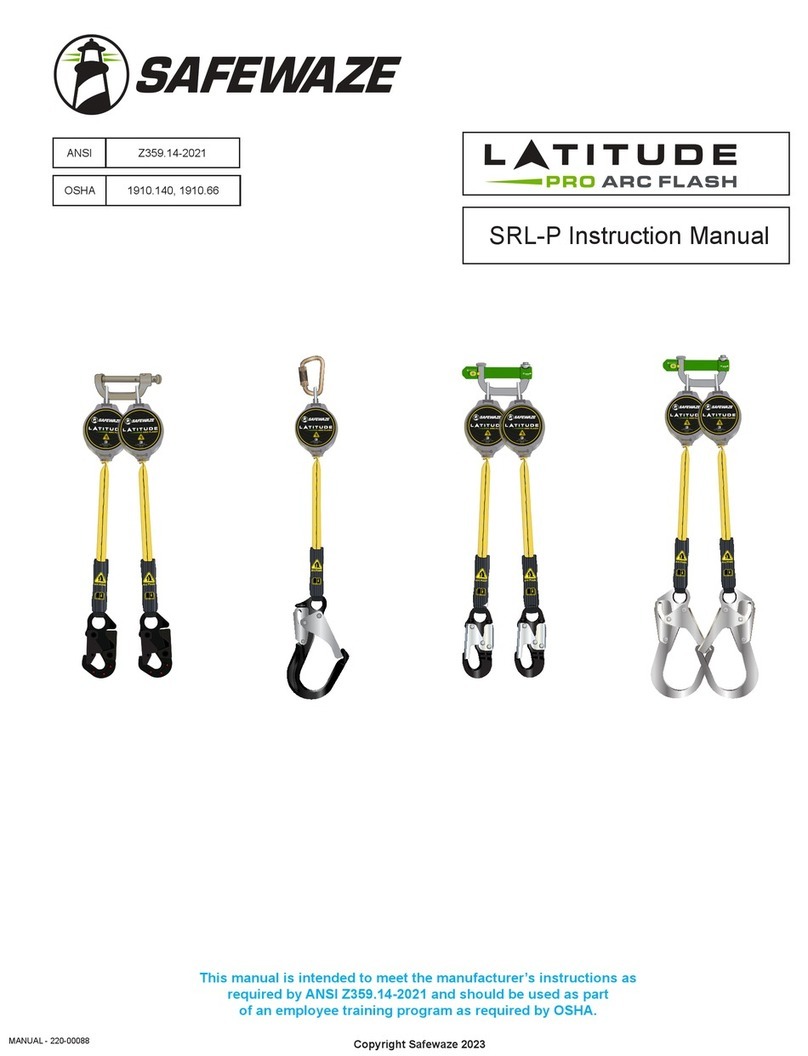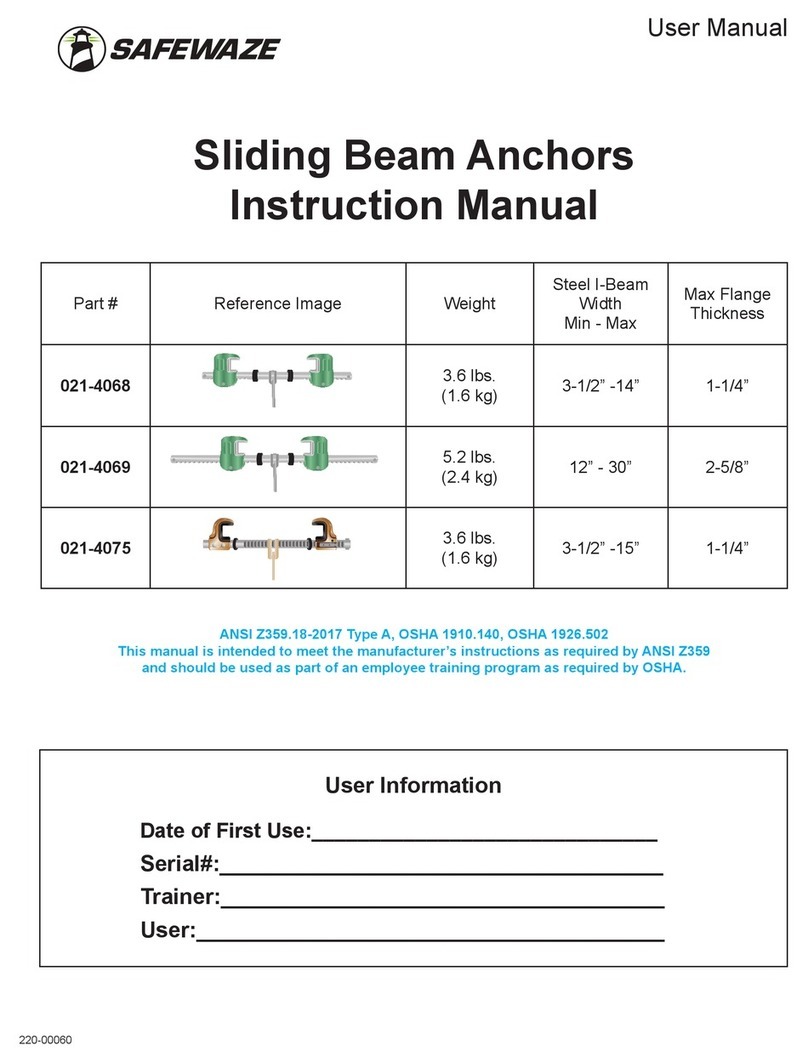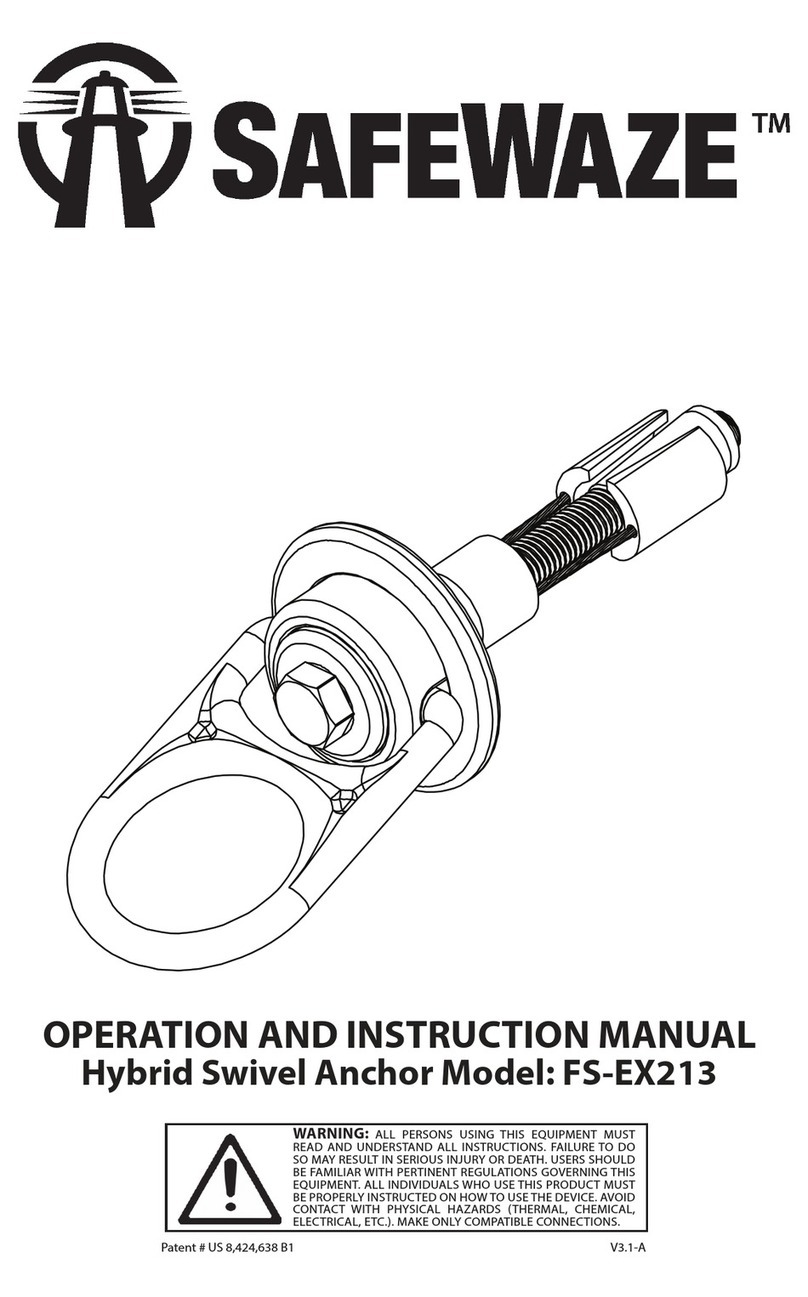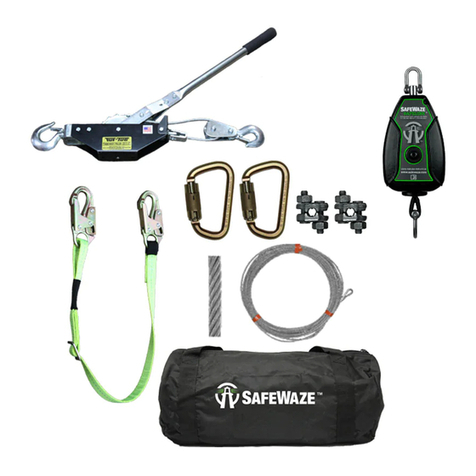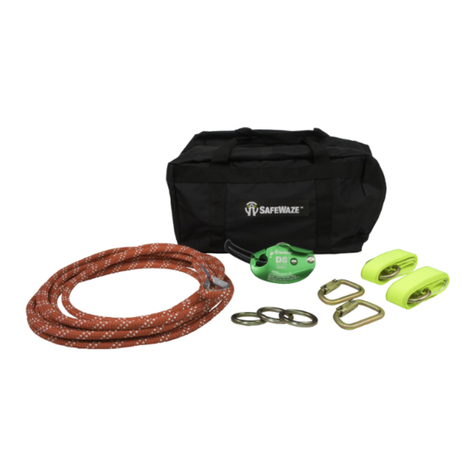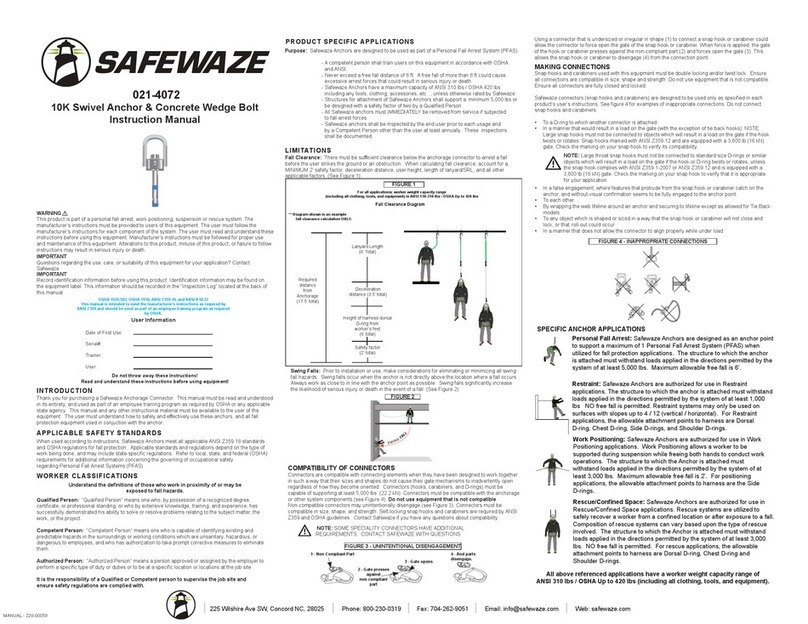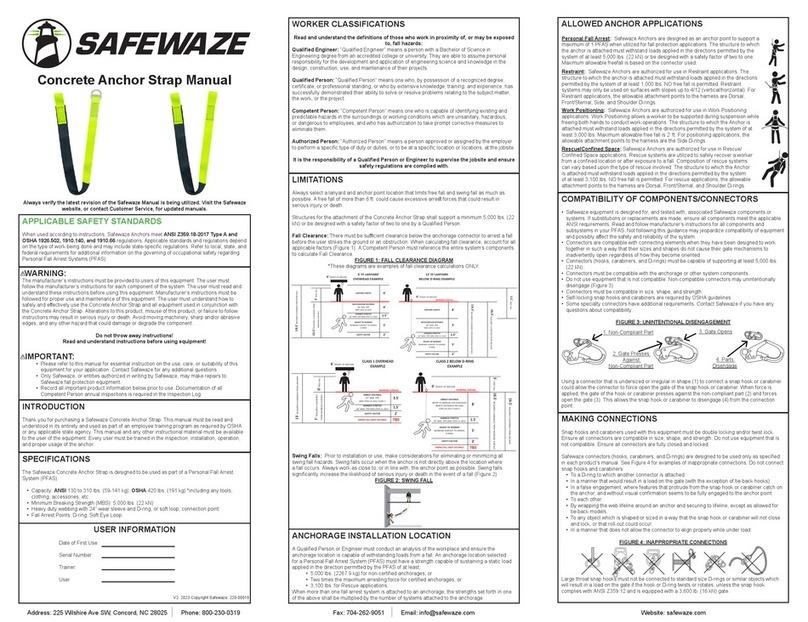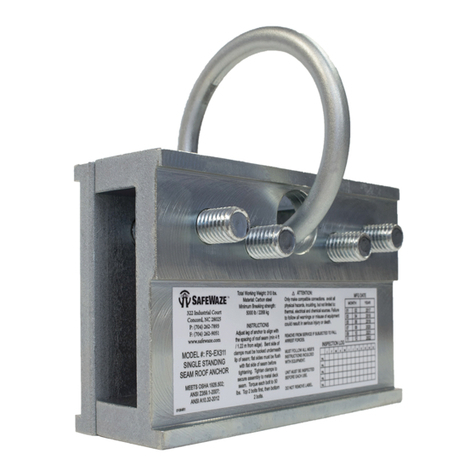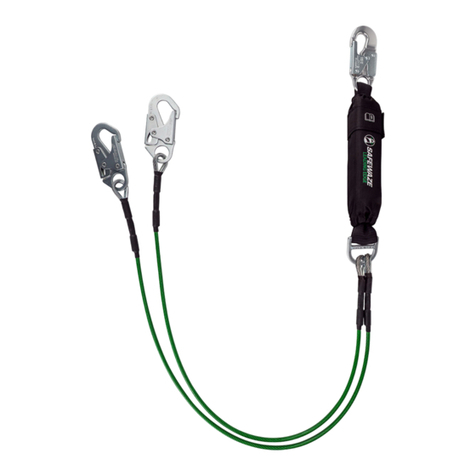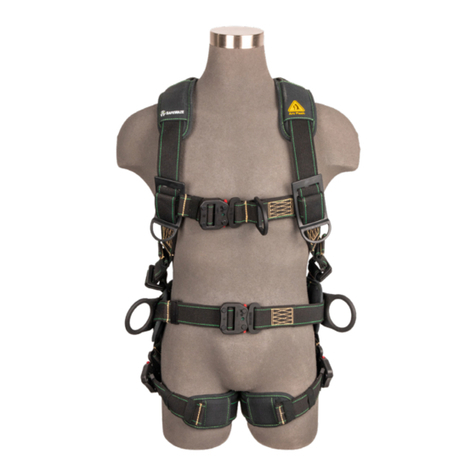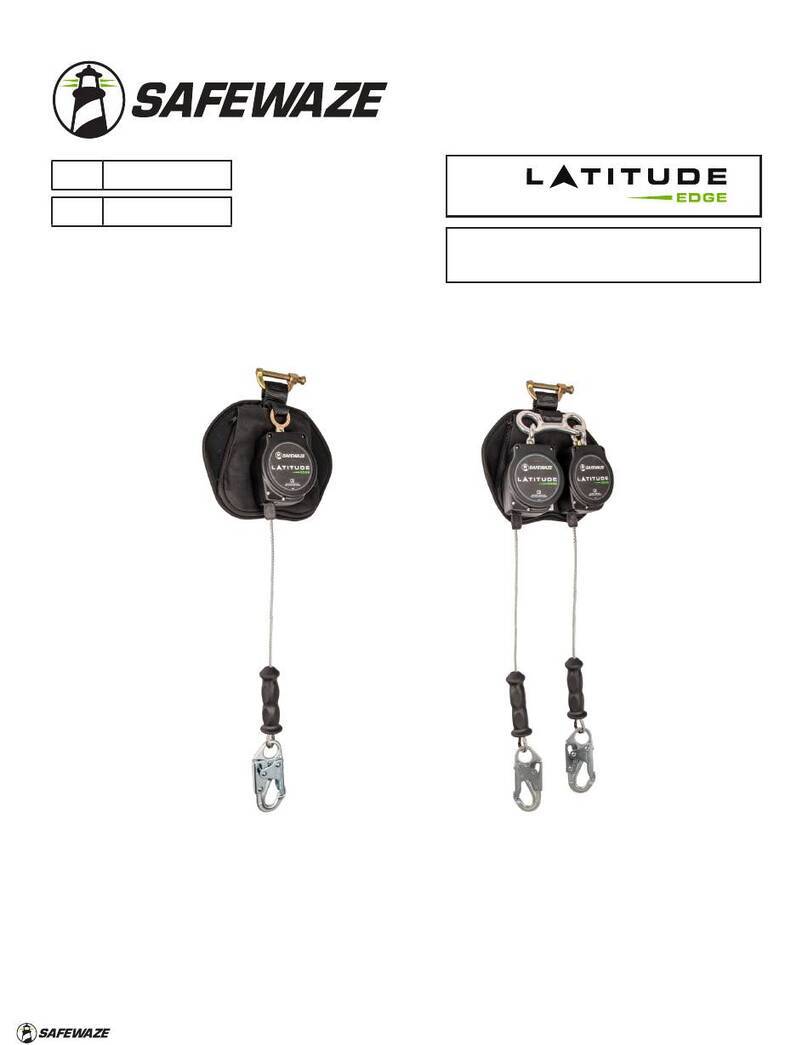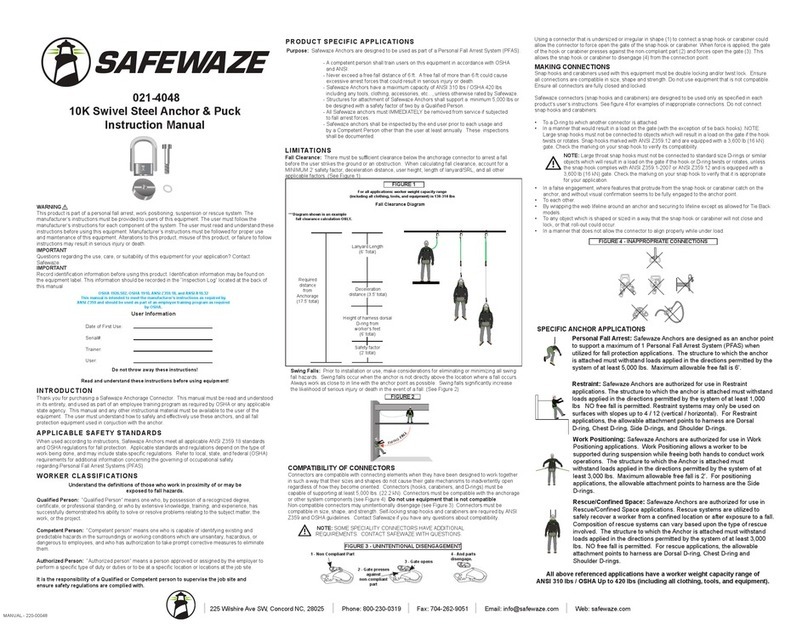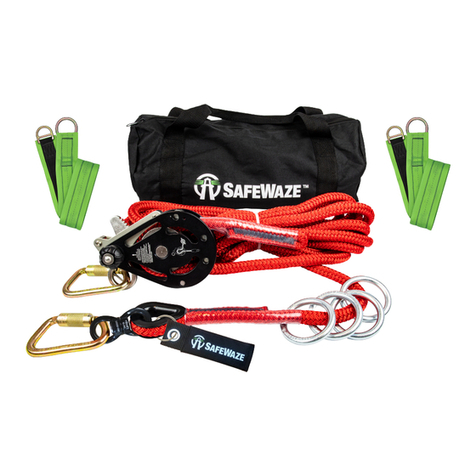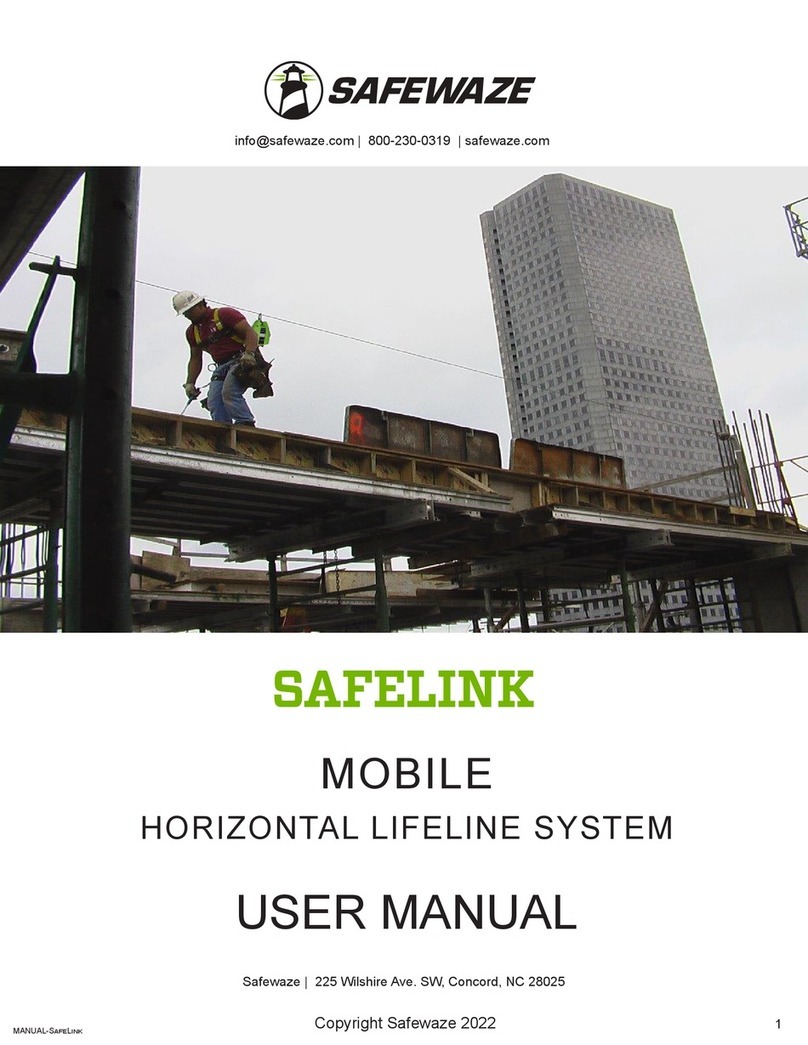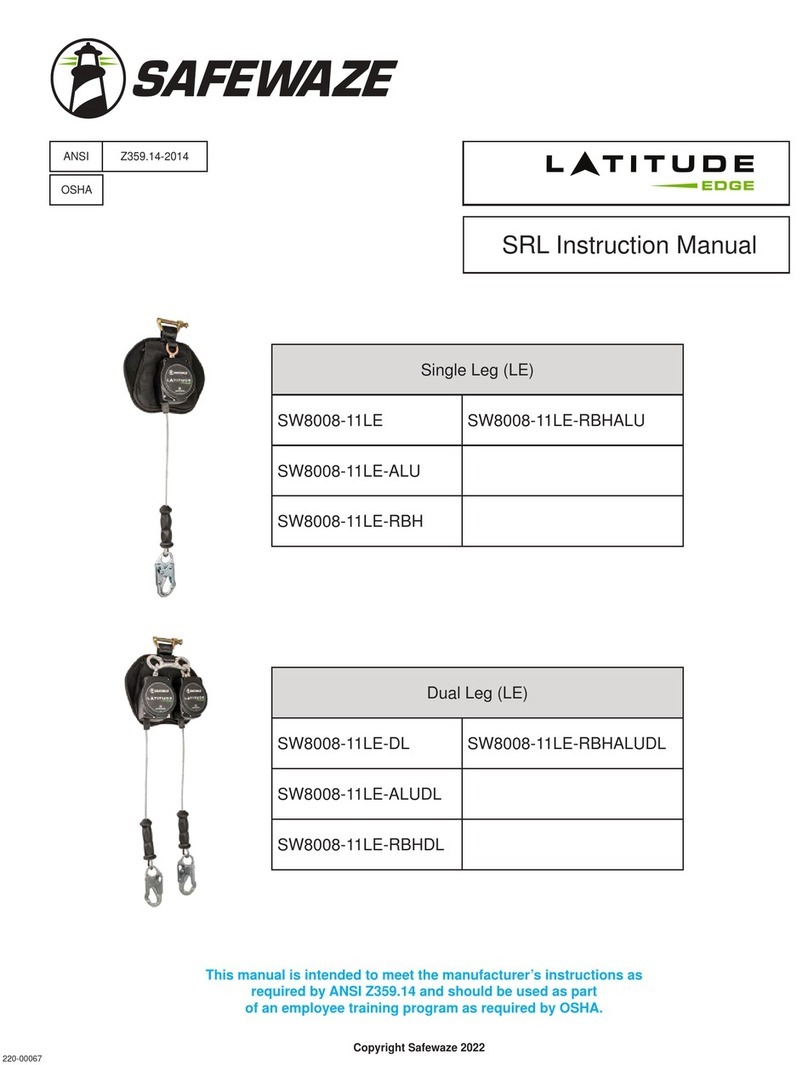
Address: 225 Wilshire Ave SW, Concord, NC 28025 Phone: 800-230-0319 Email: [email protected] Website: safewaze.comFax: 704-262-9051 I I
SPECIFIC ANCHOR APPLICATIONS
The FS860 is not for use in vertical applications or for Horizontal Lifelines.
Restraint: Safewaze Anchors are authorized for use in Restraint applications. The
structure to which the anchor is attached must withstand loads applied in the directions
permitted by the system of at least 1,000 lbs. NO free fall is permitted. Restraint
systems may only be used on surfaces with slopes up to 4/12 (vertical/horizontal). For
Restraint applications, the allowable attachment points to the harness are Dorsal,
Front/Sternal, Side, and Shoulder D-rings.
USER INFORMATION
Date of First Use:
Serial Number:
Trainer:
User:
FS860 Sliding Beam Anchor Manual
INTRODUCTION
Thank you for purchasing a Safewaze Sliding Beam Anchor. This manual must be read and
understood in its entirety and used as part of an employee training program as required by
OSHA or any applicable state agency. This manual and any other instructional material must be
available to the user of the equipment. Every user must be trained in the inspection, installation,
operation, and proper usage of the anchor.
WORKER CLASSIFICATIONS
Read and understand the denitions of those who work in proximity of, or may be
exposed to, fall hazards:
• Qualied Person: “Qualied Person” means one who, by possession of a recognized degree,
certicate, or professional standing, or who by extensive knowledge, training, and experience,
has successfully demonstrated their ability to solve or resolve problems relating to the subject
matter, the work, or the project.
• Competent Person: “Competent Person” means one who is capable of identifying existing
and predictable hazards in the surroundings or working conditions which are unsanitary,
hazardous, or dangerous to employees, and who has authorization to take prompt corrective
measures to eliminate them.
• Authorized Person: “Authorized Person” means a person approved or assigned by the
employer to perform a specic type of duty or duties, or to be at a specic location or locations,
at the jobsite.
It is the responsibility of a Qualied or Competent Person to supervise the jobsite and
ensure safety regulations are complied with.
LIMITATIONS
Always select a lanyard and anchor point location that limits free fall and swing fall as much as
possible. A free fall of more than 6 ft. could cause excessive arre forces that could result in
serious injury or death.
The Sliding Beam Anchor has a maximum capacity of ANSI 310 lbs. (140.6 kg) and OSHA
420 lbs. (190.51 kg) including any tools, clothing, accessories, etc., unless otherwise rated by
Safewaze.
Anchorages for the attachment of a Personal Fall Arrest System shall support a minimum 5,000
lbs. (22 kN) or be designed with a safety factor of two to one by a Qualied Person.
• Fall Clearance: There must be sucient clearance below the anchorage connector to arrest
a fall before the user strikes the ground or an obstruction. When calculating fall clearance,
account for a MINIMUM 2’ safety factor, deceleration distance, user height, length of lanyard/
SRL, and all other applicable factors (Figure 1).
FIGURE 1: FALL CLEARANCE DIAGRAM
*This diagram is an example of fall clearance calculation ONLY.
• Swing Falls: Prior to installation or use, make considerations for eliminating or minimizing all
swing fall hazards. Swing falls occur when the anchor is not directly above the location where
a fall occurs. Always work as close to, or in line with, the anchor point as possible. Swing falls
signicantly increase the likelihood of serious injury or death in the event of a fall (Figure 2).
FIGURE 2: SWING FALL
Lanyard Length
(6’ Total)
Deceleration
Distance (3.5’ Total)
Height of Harness Dorsal
D-ring from
Worker’s Feet
(6’ Total)
Safety Factor
(2’ Total)
Required
Distance
from
Anchorage
(17.5’ Total)
For all applications, worker weight capacity range
(including all clothing, tools, and equipment) is
ANSI 130-310 lbs./OSHA up to 420 lbs.
COMPATIBILITY OF COMPONENTS/CONNECTORS
• Safewaze equipment is designed for, and tested with, associated Safewaze components
or systems. If substitutions or replacements are made, ensure all components meet the
applicable ANSI requirements. Read and follow manufacturer’s instructions for all components
and subsystems in your PFAS. Not following this guidance may jeopardize compatibility of
equipment and possibly aect the safety and reliability of the system.
• Connectors are compatible with connecting elements when they have been designed to work
together in such a way that their sizes and shapes do not cause their gate mechanisms to
inadvertently open regardless of how they become oriented.
• Connectors (hooks, carabiners, and D-rings) must be capable of supporting at least 5,000 lbs.
(22 kN).
• Connectors must be compatible with the anchorage or other system components.
• Do not use equipment that is not compatible. Non-compatible connectors may unintentionally
disengage (Figure 3).
• Connectors must be compatible in size, shape, and strength.
• Self-locking snap hooks and carabiners are required by OSHA guidelines.
• Some specialty connectors have additional requirements. Contact Safewaze if you have any
questions about compatibility.
FIGURE 3: UNINTENTIONAL DISENGAGEMENT
Using a connector that is undersized or irregular in shape (1) to connect a snap hook or
carabiner could allow the connector to force open the gate of the snap hook or carabiner. When
force is applied, the gate of the hook or carabiner presses against the non-compliant part (2)
and forces open the gate (3). This allows the snap hook or carabiner to disengage (4) from the
connection point.
2. Gate Presses
Against
Non-Compliant Part
1. Non-Compliant Part 3. Gate Opens
4. Parts
Disengage
MAKING CONNECTIONS
Snap hooks and carabiners used with this equipment must be double locking and/or twist lock.
Ensure all connections are compatible in size, shape, and strength. Do not use equipment that is
not compatible. Ensure all connectors are fully closed and locked.
Safewaze connectors (hooks, carabiners, and D-rings) are designed to be used only as specied
in each product’s manual. See Figure 4 for examples of inappropriate connections. Do not
connect snap hooks and carabiners:
• To a D-ring to which another connector is attached.
• In a manner that would result in a load on the gate (with the exception of tie back hooks).
• In a false engagement, where features that protrude from the snap hook or carabiner catch
on the anchor, and without visual conrmation seems to be fully engaged to the anchor point.
• To each other.
• By wrapping the web lifeline around an anchor and securing to lifeline, except as allowed for
tie back models.
• To any object which is shaped or sized in a way that the snap hook or carabiner will not close
and lock, or that roll-out could occur.
• In a manner that does not allow the connector to align properly while under load.
FIGURE 4: INAPPROPRIATE CONNECTIONS
Large throat snap hooks must not be connected to standard size D-rings or similar objects which
will result in a load on the gate if the hook or D-ring twists or rotates, unless the snap hook
complies with ANSI Z359.1-2007 or ANSI Z359.12 and is equipped with a 3,600 lb. (16 kN) gate.
ANCHORAGE
An anchorage location selected for a Personal Fall Arrest System (PFAS) must have a strength
capable of sustaining a static load applied in the direction permitted by the PFAS of at least:
• Two times the maximum arrest force permitted when certication exists, or
• 5,000 lbs. (22kN) in the absence of certication
Work Positioning: Safewaze Anchors are authorized for use in Work Positioning
applications. Work Positioning allows a worker to be supported during suspension while
freeing both hands to conduct work operations. The structure to which the Anchor is
attached must withstand loads applied in the directions permitted by the system of at
least 3,000 lbs. Maximum allowable free fall is 2’ ft. For positioning applications, the
allowable attachment points to the harness are the Side D-rings.
Personal Fall Arrest: Safewaze Anchors are designed as an anchor point to support a
maximum of 1 PFAS when utilized for fall protection applications. The structure to which
the anchor is attached must withstand loads applied in the directions permitted by the
system of at least 5,000 lbs. (22 kN). Maximum allowable free fall is 6’ ft.
Rescue/Conned Space: Safewaze Anchors are authorized for use in Rescue/
Conned Space applications. Rescue systems are utilized to safely recover a worker
from a conned location or after exposure to a fall. Composition of rescue systems
can vary based upon the type of rescue involved. The structure to which the Anchor
is attached must withstand loads applied in the directions permitted by the system
of at least 3,100 lbs. NO free fall is permitted. For rescue applications, the allowable
attachment points to the harness are Dorsal, Front/Sternal, and Shoulder D-rings.
APPLICABLE SAFETY STANDARDS
When used according to instructions, Safewaze Anchors meet ANSI Z359.1-2020, A10.32-2012
and OSHA 1910.140, 1926.502 regulations. Applicable standards and regulations depend on
the type of work being done and may include state-specic regulations. Refer to local, state, and
federal requirements for additional information on the governing of occupational safety regarding
Personal Fall Arrest Systems (PFAS).
WARNING:
The manufacturer’s instructions must be provided to users of this equipment. The user must
follow the manufacturer’s instructions for each component of the system. The user must read
and understand these instructions before using this equipment. Manufacturer’s instructions must
be followed for proper use and maintenance of this equipment. The user must understand how
to safely and eectively use the FS860 beam anchor and all equipment used in conjunction with
FS860. Alterations to this product, misuse of this product, or failure to follow instructions may
result in serious injury or death. Avoid moving machinery, sharp and/or abrasive edges, and any
other hazard that could damage or degrade the component.
Do not throw away instructions!
Read and understand instructions before using equipment!
IMPORTANT:
• Please refer to this manual for essential instruction on the use, care, or suitability of this
equipment for your application. Contact Safewaze for any additional questions.
• Only Safewaze, or entities authorized in writing by Safewaze, may make repairs to
Safewaze fall protection equipment.
• Record all important product information below prior to use. Documentation of all
Competent Person annual inspections is required in the Inspection Log.
SPECIFICATIONS
• Capacity: The FS860 Beam Anchor is designed to provide a fall protection anchorage for
a single user with a maximum weight of 420 lbs.
• The center positioning retainer prevents jambing on beam.
• The anchor ts beams 3.5’’ to 14’’ with anges up to 1-1/4’’.
• Overall length of the anchor is 19’’.
• Minimum breaking strength is 5,000 lbs.

